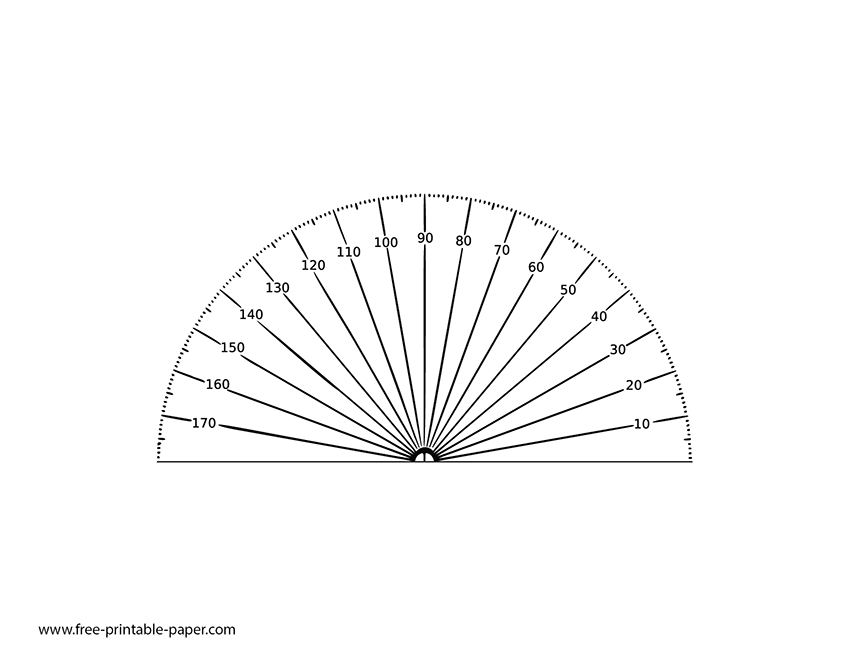

The sum of angles 1, 2, and 3 equals 360 degrees. Angle 3 is a straight line, so it follows that the sum of angles 1 and 2, 180°, is also a straight line. The sum of angles 1 and 2 is 180 degrees. What is the sum of angles 1 and 2? How does that number compare to angle 3? You should find that the angles measure as follows: Measure angles 1, 2, and 3 using a protractor to follow the steps above.
#PROTRACTOR ANGLES FULL#
As shown below, a protractor is a half or full circle measuring device, marked in degrees along the outer edge, with a straight line running from 0° to 180°. A protractor is used for measuring angles.

There are 360° in a full circle, and 90° in a right angle. That’s the value of the angle 𝜃.Degrees are the unit of measure used for angles, just as feet are used to measure distance. And when we subtract 79 degrees from this, we get an answer of 53 degrees. The protractor shown below has two scales: The outer scale starts from 0 to180 going. So to finally solve for 𝜃, we’ll go back over to our equation and replace 𝑋 with 132 degrees. A protractor is an instrument used to measure the size of angles. And this is equal to what we’ve called capital 𝑋. So, that means this second arm has an angular position of 132 degrees. Like we said earlier, each tick mark corresponds to an angular displacement of one degree. Looking carefully to see where this side of our angle crosses the tick marks, we see it intersects the second tick mark after 130 degrees. We move on past the first arm, past 90 degrees, past 100, past 110, 120, and past on through 130. We once again start from zero degrees over at the left-hand side of our protractor. The 𝑋 in this equation is equal to the angular position of the second arm of 𝜃. That angle, that value, is equal to some value we’ll solve for, let’s call it 𝑋, minus the value we just measured, 79 degrees. Now, we have to be careful because what we just found there is not equal to the angle 𝜃. That tells us that the angular reading for this particular side, or arm, of our angle is 79 degrees. Along with that, we see that this particular side of our angle, this particular ray, goes right through the last small hash mark before 80 degrees. This tells us that each one of the smaller hash marks corresponds to an angular change of one degree. So then, what exactly is this angular reading? Well, if we look and count carefully, if we start at 70 degrees, we can see there are one, two, three, four, five, six, seven, eight, and then nine small hash marks in between the two large hash marks corresponding to 70 and then 80 degrees. But rather, we’ll look at the top scale, where we’re about at 80 degrees. Which tells us, when we read off the angular measure of this first arm, we won’t look at the bottom scale, the one where we’re around 100 degrees. If we start from there and we go up to the first ray, or first arm of our angle that we encounter, we can see we go from 10 degrees, 20, 30, 40, 50, 60, 70, and around to 80 degrees. Since we’re reading this angle going from left to right, that means we’ll start at the far left side of our protractor at the angle zero. But since we’ve not done that in this case, since this angle is not rotated so one arm lies along zero degrees, that means we’ll need to read out the read directions of both of these arms and find the difference between them. Just as a quick side note, if we had aligned this angle so that one of the arms was laying along the zero degree marker, then we would only need to read out the position of the other arm relative to that. But just to pick one of them, let’s choose the bottom option, where our arrow moves from the left side to the right side. Considering these two options for a solution, we can pick either one. Whichever way we do it, we know that the angle 𝜃 will have a positive value to it. That means we could also measure the angle 𝜃 going right to left, like this. And in both cases, we could have zero as our starting point. That’s so we could read an angle going left to right this way or right to left this way. Now, taking a quick look at our protractor, we see that both ends have markings of zero as well as 180 degrees.

The measurement of this angle, the value of 𝜃, will be the angular displacement from one arm to the other. Looking at the diagram, we see the angle 𝜃, which is defined by these two arms or rays coming out from the midpoint of our protractor. The diagram shows a protractor being used to measure the angle 𝜃.


 0 kommentar(er)
0 kommentar(er)
